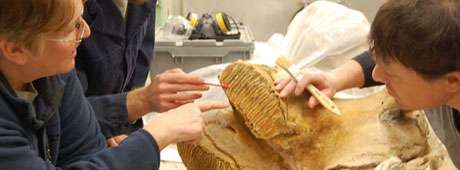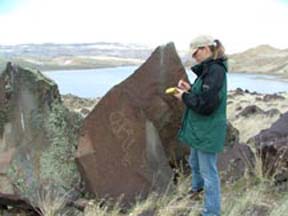No products in the cart.
Elephant in the Reservoir

At Low Water Levels, a Stunning Find
By Jennifer Rilke
Photos by David Walsh, USBR
Standing on top of the cliff, I realized I was shivering. A crisp breeze raced across the glassy reservoir below, and I was not dressed warmly enough for the mid-October morning. But I knew the shivering was caused by something else—anticipation. Below the cliff, embedded in the dirt of what is now the shoreline of American Falls Reservoir, was an exciting discovery. An extinct elephant creature had poked its head out of the ground, and I was about to lay eyes on the amazing find for the first time.
As an archaeologist for the U.S. Bureau of Reclamation, I’m responsible for protecting significant cultural resources—material remains of the human past—on the agency’s land. Mostly, I deal with prehistoric archaeology activity sites, historic trash dumps, and water control and irrigation structures related to the agency’s mission to “Manage Water in the West.” But this day’s responsibility was related to another aspect of my job—paleontological resources—which are non-renewable, irreplaceable fossil remains of plants and animals from the very distant past. Almost all these remains are from a time before people were around to interact with them. Reclamation doesn’t have any paleontologists on staff currently, so protection of this resource was given to the archaeologists—because, you know, we like old stuff.
Six days earlier, I had received word of the discovery from a geologist working as a volunteer for the agency to survey and monitor the shores of American Falls Reservoir for paleontological specimens. This is the largest reservoir on the Snake River, spanning the boundaries of Power, Bingham and Bannock Counties. Scientists have studied the area since the 1930s, and the annual fluctuations of the reservoir lead to more discoveries every year. The area is rich in vertebrate specimens from the last Ice Age, during the Pleistocene Epoch. Bison, ground sloth, saber-tooth cat, short-face bear, dire wolf and mammoth all indicate a much greener and lusher climate here in the distant past than now. Two geological layers (or horizons) are fossil-bearing, and the oldest dates back 210,000 years. That’s relatively young in the history of the earth, so no dinosaurs there. I’m not certain how much of this next statement is fact, but I was once told by a paleontologist that the fossil assemblage at American Falls Reservoir is second only to the La Brea Tar Pits in Los Angeles for diversity and sheer quantity of Ice Age vertebrate fossils in the United States. It’s an honor not taken lightly in terms of land and resource management, and it’s a potential source of pride for all Idahoans. But more on that later. Back to the discovery.
This content is available for purchase. Please select from available options.
Register & Purchase Purchase Only
Register & Purchase Purchase Only

